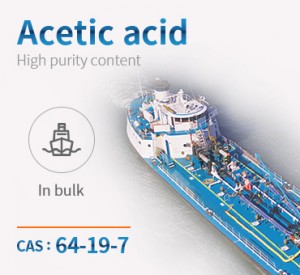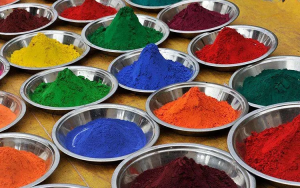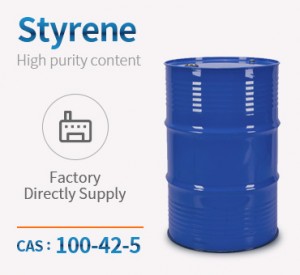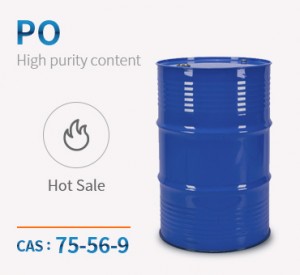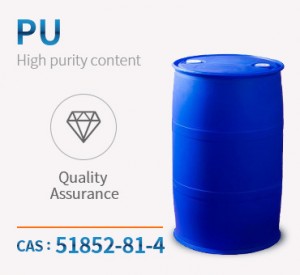ਉਤਪਾਦ ਦਾ ਨਾਮ:ਐਸੀਟਿਕ ਐਸਿਡ
ਅਣੂ ਫਾਰਮੈਟ:ਸੀ2ਐਚ4ਓ2
CAS ਨੰ:64-19-7
ਉਤਪਾਦ ਅਣੂ ਬਣਤਰ:

ਨਿਰਧਾਰਨ:
| ਆਈਟਮ | ਯੂਨਿਟ | ਮੁੱਲ |
| ਸ਼ੁੱਧਤਾ | % | 99.8ਮਿੰਟ |
| ਰੰਗ | ਏਪੀਐੱਚਏ | 5 ਅਧਿਕਤਮ |
| ਫੋਮਿਕ ਐਸਿਡ ਦੀ ਮਾਤਰਾ | % | 0.03 ਵੱਧ ਤੋਂ ਵੱਧ |
| ਪਾਣੀ ਦੀ ਮਾਤਰਾ | % | 0.15 ਵੱਧ ਤੋਂ ਵੱਧ |
| ਦਿੱਖ | - | ਪਾਰਦਰਸ਼ੀ ਤਰਲ |
ਰਸਾਇਣਕ ਗੁਣ:
ਐਸੀਟਿਕ ਐਸਿਡ, CH3COOH, ਆਲੇ ਦੁਆਲੇ ਦੇ ਤਾਪਮਾਨਾਂ 'ਤੇ ਇੱਕ ਰੰਗਹੀਣ, ਅਸਥਿਰ ਤਰਲ ਹੁੰਦਾ ਹੈ। ਸ਼ੁੱਧ ਮਿਸ਼ਰਣ, ਗਲੇਸ਼ੀਅਲ ਐਸੀਟਿਕ ਐਸਿਡ, ਇਸਦਾ ਨਾਮ 15.6°C 'ਤੇ ਇਸਦੀ ਬਰਫ਼ ਵਰਗੀ ਕ੍ਰਿਸਟਲਿਨ ਦਿੱਖ ਦੇ ਕਾਰਨ ਪਿਆ ਹੈ। ਜਿਵੇਂ ਕਿ ਆਮ ਤੌਰ 'ਤੇ ਸਪਲਾਈ ਕੀਤਾ ਜਾਂਦਾ ਹੈ, ਐਸੀਟਿਕ ਐਸਿਡ ਇੱਕ 6 N ਜਲਮਈ ਘੋਲ (ਲਗਭਗ 36%) ਜਾਂ 1 N ਘੋਲ (ਲਗਭਗ 6%) ਹੁੰਦਾ ਹੈ। ਇਹਨਾਂ ਜਾਂ ਹੋਰ ਪਤਲਿਆਂ ਦੀ ਵਰਤੋਂ ਭੋਜਨ ਵਿੱਚ ਐਸੀਟਿਕ ਐਸਿਡ ਦੀ ਢੁਕਵੀਂ ਮਾਤਰਾ ਨੂੰ ਜੋੜਨ ਲਈ ਕੀਤੀ ਜਾਂਦੀ ਹੈ। ਐਸੀਟਿਕ ਐਸਿਡ ਸਿਰਕੇ ਦਾ ਵਿਸ਼ੇਸ਼ ਐਸਿਡ ਹੈ, ਇਸਦੀ ਗਾੜ੍ਹਾਪਣ 3.5 ਤੋਂ 5.6% ਤੱਕ ਹੁੰਦੀ ਹੈ। ਐਸੀਟਿਕ ਐਸਿਡ ਅਤੇ ਐਸੀਟੇਟਸ ਜ਼ਿਆਦਾਤਰ ਪੌਦਿਆਂ ਅਤੇ ਜਾਨਵਰਾਂ ਦੇ ਟਿਸ਼ੂਆਂ ਵਿੱਚ ਛੋਟੀ ਪਰ ਖੋਜਣਯੋਗ ਮਾਤਰਾ ਵਿੱਚ ਮੌਜੂਦ ਹੁੰਦੇ ਹਨ। ਇਹ ਆਮ ਪਾਚਕ ਇੰਟਰਮੀਡੀਏਟ ਹਨ, ਐਸੀਟੋਬੈਕਟਰ ਵਰਗੀਆਂ ਬੈਕਟੀਰੀਆ ਪ੍ਰਜਾਤੀਆਂ ਦੁਆਰਾ ਪੈਦਾ ਕੀਤੇ ਜਾਂਦੇ ਹਨ ਅਤੇ ਕਲੋਸਟ੍ਰਿਡੀਅਮ ਥਰਮੋਸੈਟਿਕਮ ਵਰਗੇ ਸੂਖਮ ਜੀਵਾਣੂਆਂ ਦੁਆਰਾ ਕਾਰਬਨ ਡਾਈਆਕਸਾਈਡ ਤੋਂ ਪੂਰੀ ਤਰ੍ਹਾਂ ਸੰਸ਼ਲੇਸ਼ਿਤ ਕੀਤੇ ਜਾ ਸਕਦੇ ਹਨ। ਚੂਹਾ ਪ੍ਰਤੀ ਦਿਨ ਆਪਣੇ ਸਰੀਰ ਦੇ ਭਾਰ ਦੇ 1% ਦੀ ਦਰ ਨਾਲ ਐਸੀਟੇਟ ਬਣਾਉਂਦਾ ਹੈ।
ਇੱਕ ਰੰਗਹੀਣ ਤਰਲ ਦੇ ਰੂਪ ਵਿੱਚ ਇੱਕ ਤੇਜ਼, ਤਿੱਖੀ, ਵਿਸ਼ੇਸ਼ ਸਿਰਕੇ ਦੀ ਗੰਧ ਦੇ ਨਾਲ, ਇਹ ਮੱਖਣ, ਪਨੀਰ, ਅੰਗੂਰ ਅਤੇ ਫਲਾਂ ਦੇ ਸੁਆਦਾਂ ਵਿੱਚ ਲਾਭਦਾਇਕ ਹੈ। ਬਹੁਤ ਘੱਟ ਸ਼ੁੱਧ ਐਸੀਟਿਕ ਐਸਿਡ ਭੋਜਨ ਵਿੱਚ ਵਰਤਿਆ ਜਾਂਦਾ ਹੈ, ਹਾਲਾਂਕਿ ਇਸਨੂੰ FDA ਦੁਆਰਾ ਇੱਕ GRAS ਸਮੱਗਰੀ ਵਜੋਂ ਸ਼੍ਰੇਣੀਬੱਧ ਕੀਤਾ ਗਿਆ ਹੈ। ਨਤੀਜੇ ਵਜੋਂ, ਇਸਨੂੰ ਉਹਨਾਂ ਉਤਪਾਦਾਂ ਵਿੱਚ ਵਰਤਿਆ ਜਾ ਸਕਦਾ ਹੈ ਜੋ ਪਛਾਣ ਦੀਆਂ ਪਰਿਭਾਸ਼ਾਵਾਂ ਅਤੇ ਮਿਆਰਾਂ ਦੁਆਰਾ ਕਵਰ ਨਹੀਂ ਕੀਤੇ ਗਏ ਹਨ। ਐਸੀਟਿਕ ਐਸਿਡ ਸਿਰਕੇ ਅਤੇ ਪਾਈਰੋਲੀਗਨੀਅਸ ਐਸਿਡ ਦਾ ਮੁੱਖ ਹਿੱਸਾ ਹੈ। ਸਿਰਕੇ ਦੇ ਰੂਪ ਵਿੱਚ, 1986 ਵਿੱਚ ਭੋਜਨ ਵਿੱਚ 27 ਮਿਲੀਅਨ ਪੌਂਡ ਤੋਂ ਵੱਧ ਸ਼ਾਮਲ ਕੀਤੇ ਗਏ ਸਨ, ਜਿਸ ਵਿੱਚ ਲਗਭਗ ਬਰਾਬਰ ਮਾਤਰਾ ਵਿੱਚ ਐਸਿਡੁਲੈਂਟਸ ਅਤੇ ਸੁਆਦ ਬਣਾਉਣ ਵਾਲੇ ਏਜੰਟ ਵਜੋਂ ਵਰਤਿਆ ਜਾਂਦਾ ਸੀ। ਦਰਅਸਲ, ਐਸੀਟਿਕ ਐਸਿਡ (ਸਿਰਕੇ ਦੇ ਰੂਪ ਵਿੱਚ) ਸਭ ਤੋਂ ਪੁਰਾਣੇ ਸੁਆਦ ਬਣਾਉਣ ਵਾਲੇ ਏਜੰਟਾਂ ਵਿੱਚੋਂ ਇੱਕ ਸੀ। ਸਿਰਕੇ ਸਲਾਦ ਡ੍ਰੈਸਿੰਗ ਅਤੇ ਮੇਅਨੀਜ਼, ਖੱਟੇ ਅਤੇ ਮਿੱਠੇ ਅਚਾਰ ਅਤੇ ਕਈ ਸਾਸ ਅਤੇ ਕੈਟਅੱਪ ਤਿਆਰ ਕਰਨ ਵਿੱਚ ਵਿਆਪਕ ਤੌਰ 'ਤੇ ਵਰਤੇ ਜਾਂਦੇ ਹਨ। ਇਹਨਾਂ ਦੀ ਵਰਤੋਂ ਮੀਟ ਦੇ ਇਲਾਜ ਅਤੇ ਕੁਝ ਸਬਜ਼ੀਆਂ ਦੀ ਡੱਬਾਬੰਦੀ ਵਿੱਚ ਵੀ ਕੀਤੀ ਜਾਂਦੀ ਹੈ। ਮੇਅਨੀਜ਼ ਦੇ ਨਿਰਮਾਣ ਵਿੱਚ, ਨਮਕ- ਜਾਂ ਖੰਡ-ਜ਼ਰਦੀ ਵਿੱਚ ਐਸੀਟਿਕ ਐਸਿਡ (ਸਿਰਕੇ) ਦੇ ਇੱਕ ਹਿੱਸੇ ਨੂੰ ਜੋੜਨ ਨਾਲ ਸਾਲਮੋਨੇਲਾ ਦੀ ਗਰਮੀ ਪ੍ਰਤੀਰੋਧ ਘੱਟ ਜਾਂਦੀ ਹੈ। ਸੌਸੇਜ ਦੇ ਪਾਣੀ ਨਾਲ ਜੁੜਨ ਵਾਲੀਆਂ ਰਚਨਾਵਾਂ ਵਿੱਚ ਅਕਸਰ ਐਸੀਟਿਕ ਐਸਿਡ ਜਾਂ ਇਸਦਾ ਸੋਡੀਅਮ ਲੂਣ ਸ਼ਾਮਲ ਹੁੰਦਾ ਹੈ, ਜਦੋਂ ਕਿ ਕੈਲਸ਼ੀਅਮ ਐਸੀਟੇਟ ਦੀ ਵਰਤੋਂ ਕੱਟੀਆਂ ਹੋਈਆਂ, ਡੱਬਾਬੰਦ ਸਬਜ਼ੀਆਂ ਦੀ ਬਣਤਰ ਨੂੰ ਸੁਰੱਖਿਅਤ ਰੱਖਣ ਲਈ ਕੀਤੀ ਜਾਂਦੀ ਹੈ।
ਐਪਲੀਕੇਸ਼ਨ:
1. ਰੰਗਾਂ ਅਤੇ ਸਿਆਹੀ ਦੇ ਸੰਸਲੇਸ਼ਣ ਵਿੱਚ ਵਰਤਿਆ ਜਾਂਦਾ ਹੈ।
2. ਇਹ ਖੁਸ਼ਬੂਆਂ ਦੇ ਸੰਸਲੇਸ਼ਣ ਵਿੱਚ ਵਰਤਿਆ ਜਾਂਦਾ ਹੈ।
3. ਇਹ ਰਬੜ ਅਤੇ ਪਲਾਸਟਿਕ ਉਦਯੋਗ ਵਿੱਚ ਵਰਤਿਆ ਜਾਂਦਾ ਹੈ। ਇਹ ਰਬੜ ਅਤੇ ਪਲਾਸਟਿਕ ਉਦਯੋਗਾਂ ਵਿੱਚ ਬਹੁਤ ਸਾਰੇ ਮਹੱਤਵਪੂਰਨ ਪੋਲੀਮਰਾਂ (ਜਿਵੇਂ ਕਿ PVA, PET, ਆਦਿ) ਲਈ ਇੱਕ ਘੋਲਕ ਅਤੇ ਸ਼ੁਰੂਆਤੀ ਸਮੱਗਰੀ ਵਜੋਂ ਵਰਤਿਆ ਜਾਂਦਾ ਹੈ।
4. ਇਹ ਪੇਂਟ ਅਤੇ ਚਿਪਕਣ ਵਾਲੇ ਹਿੱਸਿਆਂ ਲਈ ਸ਼ੁਰੂਆਤੀ ਸਮੱਗਰੀ ਵਜੋਂ ਵਰਤਿਆ ਜਾਂਦਾ ਹੈ।
5. ਇਸਦੀ ਵਰਤੋਂ ਫੂਡ ਪ੍ਰੋਸੈਸਿੰਗ ਉਦਯੋਗ ਵਿੱਚ ਪਨੀਰ ਅਤੇ ਸਾਸ ਵਿੱਚ ਇੱਕ ਐਡਿਟਿਵ ਅਤੇ ਇੱਕ ਫੂਡ ਪ੍ਰਜ਼ਰਵੇਟਿਵ ਵਜੋਂ ਕੀਤੀ ਜਾਂਦੀ ਹੈ।
ਉਤਪਾਦਾਂ ਦੀਆਂ ਸ਼੍ਰੇਣੀਆਂ
-

ਫ਼ੋਨ
-

ਈ-ਮੇਲ
-

ਵਟਸਐਪ
-

ਸਿਖਰ


